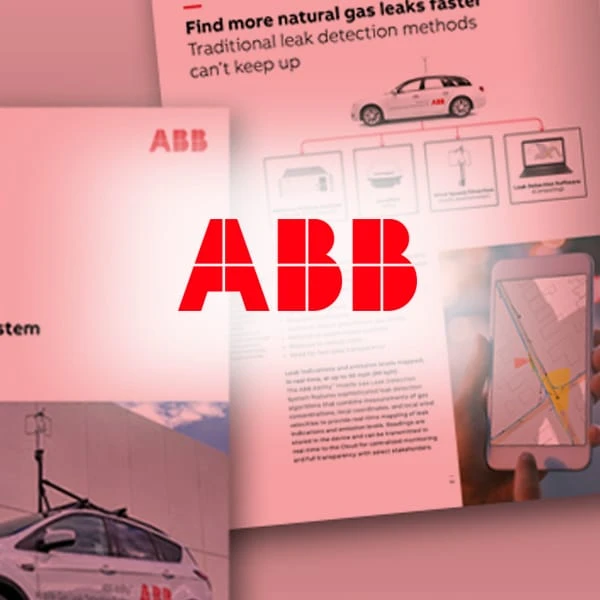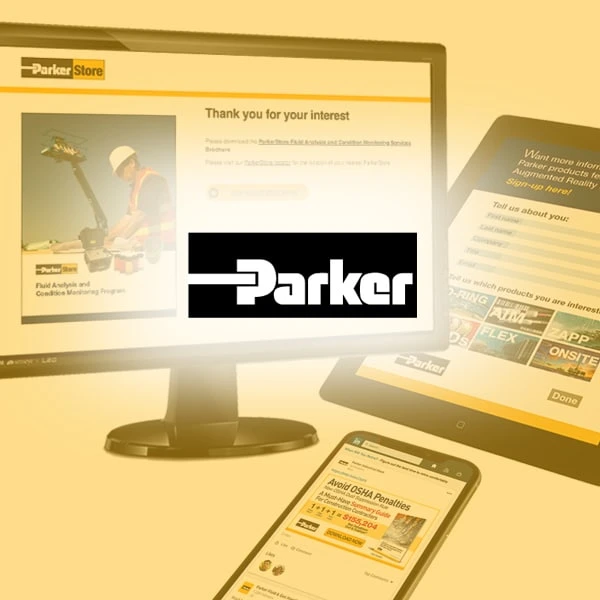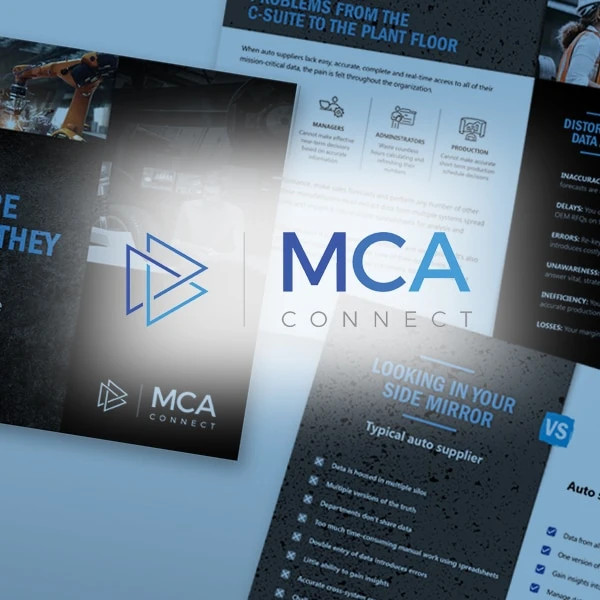In today’s competitive marketplace, too many manufacturers struggle to meaningfully differentiate their products from those of their competitors.
How Leading Manufacturers Used Creativity to Boost Marketing Success

In today’s competitive marketplace, too many manufacturers struggle to meaningfully differentiate their products from those of their competitors. Many face the challenge of marketing products that, on the surface, appear almost identical to others in the marketplace. This similarity makes it more difficult for any single brand to stand out. Additionally, some products are inherently utilitarian and may be perceived as boring, making it even more challenging to capture the attention of potential buyers. Compounding these issues is the fact that many manufacturers approach marketing with an engineering mindset—focused on features and benefits—rather than embracing the creativity that can make their products truly shine.
But injecting creativity into marketing strategies can transform these challenges into opportunities. Creative marketing not only helps differentiate a brand but also makes its campaigns more compelling, memorable and effective. By stepping away from a purely technical perspective and embracing a more imaginative approach, manufacturers highlight their products’ features and benefits in unique and engaging ways. This not only attracts attention but also fosters a deeper connection with potential buyers, ultimately leading to increased interest and sales.
In this post, we’ll explore how manufacturers can leverage creativity to enhance their marketing efforts, using innovative examples to illustrate the power of thinking outside the box. From interactive displays and clever metaphors to powerful visual storytelling, discover how creativity can breathe new life into manufacturing marketing and set your brand apart from the competition.
Finding Creative Ideas for Manufacturing Marketing
But first, let’s address the fundamental challenge. Where do manufacturers find these creative ideas to transform their marketing efforts? The answer lies in a deep, thorough understanding of both buyer challenges and product benefits. Creativity doesn’t come from thin air—it emerges from insights gained through extensive research and a keen understanding of the market. Here are some effective ways to uncover those creative insights:
Talk with Customers
Engaging directly with customers is one of the best ways to find creative marketing ideas. Conversations with your existing and potential customers can reveal the pains and challenges they face, as well as the specific benefits they value most in your products. Listen to their stories, understand their needs, and pay attention to the language they use. This firsthand information can inspire new, creative ways to communicate your product’s value.
Examine the Pains and Challenges Your Products Solve
Creativity in marketing often stems from a clear understanding of the problems your products solve. Take a close look at the common challenges faced by your target audience. What pain points are your products addressing? How do they make your customers’ lives easier or better? By focusing on these aspects, you can craft messages that resonate deeply with potential buyers and highlight your product’s relevance in their lives.
Brainstorming
Organize brainstorming sessions with your marketing team, sales team, and even your engineers. Different perspectives spark innovative ideas. During these sessions, explore various ways to describe the market, a customer challenge, or a specific product feature or benefit. Encourage free thinking and open discussion—sometimes the most unconventional ideas turn out to be the most effective.
Go Beyond Traditional Creative Briefs
Traditional creative briefs are a good starting point, but they often don’t go far enough in uncovering unique insights. To generate truly creative marketing ideas, dive deeper into the buyer’s journey and the product’s lifecycle. Conduct thorough research to understand what buyers need, what motivates them, and what barriers they face. Look for unique aspects of your product that are not immediately obvious but can be highlighted creatively to differentiate it from the competition.
Ground Creativity in Insights
Creative marketing must be rooted in solid insights. These insights come from an exhaustive analysis of buyer behavior, market trends, and product performance. Utilize data analytics, customer feedback, and competitive analysis to gather information to inform your creative strategies. Understanding what drives your customers and how your product fits into their world is crucial for developing marketing that not only grabs attention but also drives action.
Real-World Examples and Case Studies
Examine how other companies, both within and outside your industry, have successfully used creativity in their marketing. Real-world examples and case studies can provide inspiration and demonstrate how creative ideas can be applied effectively. Look for campaigns that have broken through the noise and analyze what made them successful.
Emphasize Storytelling
One of the most powerful tools in creative marketing is storytelling. Craft stories that connect your product to the customer’s needs and aspirations. A well-told story can make complex features more relatable and memorable. Whether it’s through customer testimonials, product demonstrations, or hypothetical scenarios, storytelling can bring your product’s benefits to life in a compelling way.
Finding creative marketing ideas for manufacturing requires a deep understanding of your buyers and your products. By talking with customers, examining the problems your products solve, brainstorming creatively, going beyond traditional creative briefs, grounding your ideas in solid insights, and leveraging storytelling, you can uncover unique and powerful ways to market your products. These creative strategies not only help you stand out in a crowded marketplace but also drive greater awareness and sales.
RH Blake Examples: See how three manufacturers used creativity to differentiate their brands, increase awareness, and improve marketing performance.
Parker
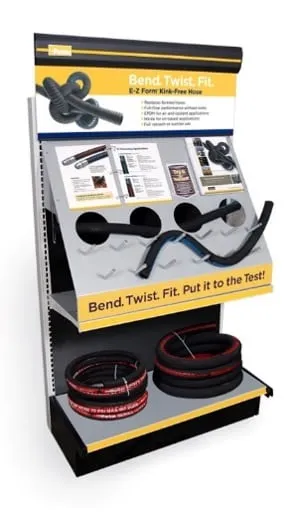 Parker manufacturers a line of hoses that don’t kink. They needed a unique way to communicate their kink-free capability in a way that grabs attention in a crowded marketplace and drives sales opportunities.. The manufacturer effectively used a point-of-purchase display to showcase their kink-free hose through several creative strategies. RH Blake created a dramatic visual that showed how extremely flexible the hose is while grabbing the attention of engineers because this hose would never need to be this curled up in any application. Our campaign stood out for its:
Parker manufacturers a line of hoses that don’t kink. They needed a unique way to communicate their kink-free capability in a way that grabs attention in a crowded marketplace and drives sales opportunities.. The manufacturer effectively used a point-of-purchase display to showcase their kink-free hose through several creative strategies. RH Blake created a dramatic visual that showed how extremely flexible the hose is while grabbing the attention of engineers because this hose would never need to be this curled up in any application. Our campaign stood out for its:
- Interactive Design: The display encourages customers to “Bend. Twist. Fit. Put it to the Test!” This interactive element engages customers directly, allowing them to physically manipulate the hose and experience its flexibility and kink-free properties firsthand. This hands-on approach can significantly enhance customer confidence in the product’s claims.
- Visual Demonstration: By displaying the hose in various twisted and bent positions, the manufacturer visually demonstrates the product’s durability and flexibility. This visual proof reinforces the product’s key selling point—its kink-free nature.
- Clear Messaging: The display prominently features the product’s key benefits, such as “Rubber formed hoses without kinks” and suitability for various applications, including “EGR and air coolant applications” and “Vacuum or suction use.” These clear, concise messages ensure that customers quickly understand the unique advantages of the hose.
- Professional Presentation: The display is well-organized and visually appealing, with a clean design that highlights the hose without clutter. The professional presentation helps attract attention and conveys a sense of quality.
- Informative Content: In addition to the physical demonstration, the display includes informative content about the hose’s applications and features. This educates potential customers on the product’s uses and benefits, helping them make an informed purchasing decision.
- Brand Visibility: The Parker brand is clearly displayed at the top, reinforcing brand recognition and trust. Customers familiar with the brand may be more inclined to trust the product’s quality.
Overall, this point-of-purchase display effectively combines interactive elements, clear messaging, visual demonstrations, professional presentation, informative content, and strong brand visibility to create a compelling and persuasive marketing tool. By engaging customers directly and allowing them to experience the product’s key feature firsthand, the manufacturer leverages creativity to enhance their marketing effectiveness.
Caster Connection
 This manufacturer of industrial casters needed a creative way to communicate that its line of extra-quiet casters were ideal for hospitals. Through our research, we discovered that our client’s healthcare customers had an elevated need to touch and feel a product to appreciate its advantages. Our challenge was creating a compelling marketing piece to educate the audience that our client’s casters reduce noise and improve the patient experience.
This manufacturer of industrial casters needed a creative way to communicate that its line of extra-quiet casters were ideal for hospitals. Through our research, we discovered that our client’s healthcare customers had an elevated need to touch and feel a product to appreciate its advantages. Our challenge was creating a compelling marketing piece to educate the audience that our client’s casters reduce noise and improve the patient experience.
We created a visual that converted a caster wheel into the dial on a radio, signifying a way to reduce noise. We was used this visual across multiple marketing channels. This creative approach featured:
- Clever Metaphor: By depicting a caster as the volume dial of an FM/AM radio, the manufacturer creates a strong visual metaphor that immediately communicates the primary benefit of their product: noise reduction. This clever metaphor simplifies the message, making it easy for viewers to grasp the idea that using these casters can “turn down the volume” in environments like hospitals where quiet is essential.
- Contextual Relevance: The ad specifically targets hospitals, a setting where noise reduction is particularly important. The phrase “Turn down the volume in your hospital” directly addresses a common concern in healthcare environments, making the product’s benefit highly relevant to the target audience.
- Visual Impact: The image of the radio with the caster as a volume knob is eye-catching and memorable. This unique visual is likely to stand out in a trade publication, capturing the attention of readers and making the ad more effective.
- Concise Messaging: The text is brief and to the point, reinforcing the visual message without overwhelming the viewer with information. This ensures that the primary benefit—quiet operation—is communicated quickly and clearly.
- Product Focus: Despite the creative presentation, the product itself remains the focal point of the ad. The caster is prominently displayed and easily identifiable, ensuring that viewers understand exactly what is being advertised.
- Implied Benefits: By associating the caster with the volume control of a radio, the ad implies that the product offers a high level of control over noise levels, suggesting precision and effectiveness. This can be particularly appealing to decision-makers in hospitals who are looking for reliable solutions to noise-related issues.
Overall, this ad effectively uses a clever metaphor, contextual relevance, visual impact, concise messaging, product focus, and implied benefits to communicate the value of the manufacturer’s noise-reducing casters. By doing so, it captures the attention of the target audience and clearly conveys the product’s key advantage in a memorable and engaging way.
3M
 This manufacturer of safety equipment for welders needed a way to grab attention and differentiate its product line. They were competing with brands that typically feature images of their products in their ads. We came up with a more creative approach. We cut through the noise to promote the manufacturer’s line of safety equipment for welders in a novel way. Our creative and thought-provoking campaign featured several key strategies:
This manufacturer of safety equipment for welders needed a way to grab attention and differentiate its product line. They were competing with brands that typically feature images of their products in their ads. We came up with a more creative approach. We cut through the noise to promote the manufacturer’s line of safety equipment for welders in a novel way. Our creative and thought-provoking campaign featured several key strategies:
- Powerful Visual Metaphor: Each ad features a striking visual representation of what the world would be like without welders. By showing everyday items that are poorly held together with clothespins, chewing gum, rope, and tape, the ads emphasize the crucial role welders play in creating strong, reliable structures. This metaphor powerfully underscores the importance of welding and, by extension, the safety of those who perform it.
- Unified Theme: The consistent theme across all four ads—“A World Without Welders?”—creates a cohesive campaign that is easily recognizable. This repetition helps reinforce the message and makes the ads more memorable. Each visual variation reinforces the same core idea, building a stronger overall impact.
- Emotional Appeal: By imagining a world where welders do not exist, the ads evoke an emotional response. They highlight the potential chaos and inefficiency in a world without welders, making viewers appreciate the value of the welding profession. This emotional appeal can resonate deeply with the target audience, who understand the importance of their work.
- Focus on Safety: The ads subtly shift the focus to the importance of safety for welders by showing the brand’s safety equipment at the bottom. The message implies that just as the world needs welders, welders need the best safety equipment to do their job effectively and safely. This association reinforces the manufacturer’s commitment to the well-being of welders.
- Effective Use of Minimal Text: The ads use minimal text, which makes them visually impactful and easy to understand at a glance. The phrase “A World Without Welders? We can’t see it either.” is concise and directly addresses the essential role of welders. The call to action to protect welders’ health further emphasizes the focus on safety equipment.
- Brand Recognition: The prominent display of the 3M logo and product images at the bottom of each ad ensures that the brand is clearly associated with the message. This helps in building brand recognition and trust among the target audience.
- Targeted Messaging: The ads are tailored for trade publications, meaning they are specifically designed to reach professionals in the welding industry. This targeted approach ensures that the message is seen by those who are most likely to benefit from the products being advertised.
Overall, the manufacturer effectively uses a combination of powerful visual metaphors, a unified theme, emotional appeal, focus on safety, minimal text, brand recognition, and targeted messaging to promote its line of safety equipment for welders. This creative approach not only highlights the importance of welders but also emphasizes the need for reliable safety gear to protect these essential workers.
Conclusion
In the crowded and competitive world of manufacturing, standing out requires more than just highlighting product features and benefits. It demands a creative approach that resonates with your audience and differentiates your brand. By tapping into the pains and challenges that your products solve, talking directly with customers, and brainstorming innovative ways to present your offerings, you uncover unique marketing ideas that break through the noise.
Creativity in marketing is not an abstract concept; it’s grounded in a thorough understanding of buyer needs and product benefits. It requires going beyond traditional creative briefs to gain deeper insights into what drives your customers and how your products fit into their lives. Real-world examples, effective storytelling, and data-driven insights all play crucial roles in developing compelling and memorable marketing campaigns.
Ultimately, embracing creativity in your marketing strategy can transform your brand, making your products more appealing and your marketing efforts more effective. By leveraging the power of creative thinking, manufacturers not only capture the attention of their target audience but also build stronger connections and drive long-term success. So, step into the world of creative marketing—your brand and your bottom line will thank you.
If you need a marketing partner to help you on your journey, let’s talk.
In today’s competitive marketplace, too many manufacturers struggle to meaningfully differentiate their products from those of their competitors.
How Leading Manufacturers Used Creativity to Boost Marketing Success

In today’s competitive marketplace, too many manufacturers struggle to meaningfully differentiate their products from those of their competitors. Many face the challenge of marketing products that, on the surface, appear almost identical to others in the marketplace. This similarity makes it more difficult for any single brand to stand out. Additionally, some products are inherently utilitarian and may be perceived as boring, making it even more challenging to capture the attention of potential buyers. Compounding these issues is the fact that many manufacturers approach marketing with an engineering mindset—focused on features and benefits—rather than embracing the creativity that can make their products truly shine.
But injecting creativity into marketing strategies can transform these challenges into opportunities. Creative marketing not only helps differentiate a brand but also makes its campaigns more compelling, memorable and effective. By stepping away from a purely technical perspective and embracing a more imaginative approach, manufacturers highlight their products’ features and benefits in unique and engaging ways. This not only attracts attention but also fosters a deeper connection with potential buyers, ultimately leading to increased interest and sales.
In this post, we’ll explore how manufacturers can leverage creativity to enhance their marketing efforts, using innovative examples to illustrate the power of thinking outside the box. From interactive displays and clever metaphors to powerful visual storytelling, discover how creativity can breathe new life into manufacturing marketing and set your brand apart from the competition.
Finding Creative Ideas for Manufacturing Marketing
But first, let’s address the fundamental challenge. Where do manufacturers find these creative ideas to transform their marketing efforts? The answer lies in a deep, thorough understanding of both buyer challenges and product benefits. Creativity doesn’t come from thin air—it emerges from insights gained through extensive research and a keen understanding of the market. Here are some effective ways to uncover those creative insights:
Talk with Customers
Engaging directly with customers is one of the best ways to find creative marketing ideas. Conversations with your existing and potential customers can reveal the pains and challenges they face, as well as the specific benefits they value most in your products. Listen to their stories, understand their needs, and pay attention to the language they use. This firsthand information can inspire new, creative ways to communicate your product’s value.
Examine the Pains and Challenges Your Products Solve
Creativity in marketing often stems from a clear understanding of the problems your products solve. Take a close look at the common challenges faced by your target audience. What pain points are your products addressing? How do they make your customers’ lives easier or better? By focusing on these aspects, you can craft messages that resonate deeply with potential buyers and highlight your product’s relevance in their lives.
Brainstorming
Organize brainstorming sessions with your marketing team, sales team, and even your engineers. Different perspectives spark innovative ideas. During these sessions, explore various ways to describe the market, a customer challenge, or a specific product feature or benefit. Encourage free thinking and open discussion—sometimes the most unconventional ideas turn out to be the most effective.
Go Beyond Traditional Creative Briefs
Traditional creative briefs are a good starting point, but they often don’t go far enough in uncovering unique insights. To generate truly creative marketing ideas, dive deeper into the buyer’s journey and the product’s lifecycle. Conduct thorough research to understand what buyers need, what motivates them, and what barriers they face. Look for unique aspects of your product that are not immediately obvious but can be highlighted creatively to differentiate it from the competition.
Ground Creativity in Insights
Creative marketing must be rooted in solid insights. These insights come from an exhaustive analysis of buyer behavior, market trends, and product performance. Utilize data analytics, customer feedback, and competitive analysis to gather information to inform your creative strategies. Understanding what drives your customers and how your product fits into their world is crucial for developing marketing that not only grabs attention but also drives action.
Real-World Examples and Case Studies
Examine how other companies, both within and outside your industry, have successfully used creativity in their marketing. Real-world examples and case studies can provide inspiration and demonstrate how creative ideas can be applied effectively. Look for campaigns that have broken through the noise and analyze what made them successful.
Emphasize Storytelling
One of the most powerful tools in creative marketing is storytelling. Craft stories that connect your product to the customer’s needs and aspirations. A well-told story can make complex features more relatable and memorable. Whether it’s through customer testimonials, product demonstrations, or hypothetical scenarios, storytelling can bring your product’s benefits to life in a compelling way.
Finding creative marketing ideas for manufacturing requires a deep understanding of your buyers and your products. By talking with customers, examining the problems your products solve, brainstorming creatively, going beyond traditional creative briefs, grounding your ideas in solid insights, and leveraging storytelling, you can uncover unique and powerful ways to market your products. These creative strategies not only help you stand out in a crowded marketplace but also drive greater awareness and sales.
RH Blake Examples: See how three manufacturers used creativity to differentiate their brands, increase awareness, and improve marketing performance.
Parker
 Parker manufacturers a line of hoses that don’t kink. They needed a unique way to communicate their kink-free capability in a way that grabs attention in a crowded marketplace and drives sales opportunities.. The manufacturer effectively used a point-of-purchase display to showcase their kink-free hose through several creative strategies. RH Blake created a dramatic visual that showed how extremely flexible the hose is while grabbing the attention of engineers because this hose would never need to be this curled up in any application. Our campaign stood out for its:
Parker manufacturers a line of hoses that don’t kink. They needed a unique way to communicate their kink-free capability in a way that grabs attention in a crowded marketplace and drives sales opportunities.. The manufacturer effectively used a point-of-purchase display to showcase their kink-free hose through several creative strategies. RH Blake created a dramatic visual that showed how extremely flexible the hose is while grabbing the attention of engineers because this hose would never need to be this curled up in any application. Our campaign stood out for its:
- Interactive Design: The display encourages customers to “Bend. Twist. Fit. Put it to the Test!” This interactive element engages customers directly, allowing them to physically manipulate the hose and experience its flexibility and kink-free properties firsthand. This hands-on approach can significantly enhance customer confidence in the product’s claims.
- Visual Demonstration: By displaying the hose in various twisted and bent positions, the manufacturer visually demonstrates the product’s durability and flexibility. This visual proof reinforces the product’s key selling point—its kink-free nature.
- Clear Messaging: The display prominently features the product’s key benefits, such as “Rubber formed hoses without kinks” and suitability for various applications, including “EGR and air coolant applications” and “Vacuum or suction use.” These clear, concise messages ensure that customers quickly understand the unique advantages of the hose.
- Professional Presentation: The display is well-organized and visually appealing, with a clean design that highlights the hose without clutter. The professional presentation helps attract attention and conveys a sense of quality.
- Informative Content: In addition to the physical demonstration, the display includes informative content about the hose’s applications and features. This educates potential customers on the product’s uses and benefits, helping them make an informed purchasing decision.
- Brand Visibility: The Parker brand is clearly displayed at the top, reinforcing brand recognition and trust. Customers familiar with the brand may be more inclined to trust the product’s quality.
Overall, this point-of-purchase display effectively combines interactive elements, clear messaging, visual demonstrations, professional presentation, informative content, and strong brand visibility to create a compelling and persuasive marketing tool. By engaging customers directly and allowing them to experience the product’s key feature firsthand, the manufacturer leverages creativity to enhance their marketing effectiveness.
Caster Connection
 This manufacturer of industrial casters needed a creative way to communicate that its line of extra-quiet casters were ideal for hospitals. Through our research, we discovered that our client’s healthcare customers had an elevated need to touch and feel a product to appreciate its advantages. Our challenge was creating a compelling marketing piece to educate the audience that our client’s casters reduce noise and improve the patient experience.
This manufacturer of industrial casters needed a creative way to communicate that its line of extra-quiet casters were ideal for hospitals. Through our research, we discovered that our client’s healthcare customers had an elevated need to touch and feel a product to appreciate its advantages. Our challenge was creating a compelling marketing piece to educate the audience that our client’s casters reduce noise and improve the patient experience.
We created a visual that converted a caster wheel into the dial on a radio, signifying a way to reduce noise. We was used this visual across multiple marketing channels. This creative approach featured:
- Clever Metaphor: By depicting a caster as the volume dial of an FM/AM radio, the manufacturer creates a strong visual metaphor that immediately communicates the primary benefit of their product: noise reduction. This clever metaphor simplifies the message, making it easy for viewers to grasp the idea that using these casters can “turn down the volume” in environments like hospitals where quiet is essential.
- Contextual Relevance: The ad specifically targets hospitals, a setting where noise reduction is particularly important. The phrase “Turn down the volume in your hospital” directly addresses a common concern in healthcare environments, making the product’s benefit highly relevant to the target audience.
- Visual Impact: The image of the radio with the caster as a volume knob is eye-catching and memorable. This unique visual is likely to stand out in a trade publication, capturing the attention of readers and making the ad more effective.
- Concise Messaging: The text is brief and to the point, reinforcing the visual message without overwhelming the viewer with information. This ensures that the primary benefit—quiet operation—is communicated quickly and clearly.
- Product Focus: Despite the creative presentation, the product itself remains the focal point of the ad. The caster is prominently displayed and easily identifiable, ensuring that viewers understand exactly what is being advertised.
- Implied Benefits: By associating the caster with the volume control of a radio, the ad implies that the product offers a high level of control over noise levels, suggesting precision and effectiveness. This can be particularly appealing to decision-makers in hospitals who are looking for reliable solutions to noise-related issues.
Overall, this ad effectively uses a clever metaphor, contextual relevance, visual impact, concise messaging, product focus, and implied benefits to communicate the value of the manufacturer’s noise-reducing casters. By doing so, it captures the attention of the target audience and clearly conveys the product’s key advantage in a memorable and engaging way.
3M
 This manufacturer of safety equipment for welders needed a way to grab attention and differentiate its product line. They were competing with brands that typically feature images of their products in their ads. We came up with a more creative approach. We cut through the noise to promote the manufacturer’s line of safety equipment for welders in a novel way. Our creative and thought-provoking campaign featured several key strategies:
This manufacturer of safety equipment for welders needed a way to grab attention and differentiate its product line. They were competing with brands that typically feature images of their products in their ads. We came up with a more creative approach. We cut through the noise to promote the manufacturer’s line of safety equipment for welders in a novel way. Our creative and thought-provoking campaign featured several key strategies:
- Powerful Visual Metaphor: Each ad features a striking visual representation of what the world would be like without welders. By showing everyday items that are poorly held together with clothespins, chewing gum, rope, and tape, the ads emphasize the crucial role welders play in creating strong, reliable structures. This metaphor powerfully underscores the importance of welding and, by extension, the safety of those who perform it.
- Unified Theme: The consistent theme across all four ads—“A World Without Welders?”—creates a cohesive campaign that is easily recognizable. This repetition helps reinforce the message and makes the ads more memorable. Each visual variation reinforces the same core idea, building a stronger overall impact.
- Emotional Appeal: By imagining a world where welders do not exist, the ads evoke an emotional response. They highlight the potential chaos and inefficiency in a world without welders, making viewers appreciate the value of the welding profession. This emotional appeal can resonate deeply with the target audience, who understand the importance of their work.
- Focus on Safety: The ads subtly shift the focus to the importance of safety for welders by showing the brand’s safety equipment at the bottom. The message implies that just as the world needs welders, welders need the best safety equipment to do their job effectively and safely. This association reinforces the manufacturer’s commitment to the well-being of welders.
- Effective Use of Minimal Text: The ads use minimal text, which makes them visually impactful and easy to understand at a glance. The phrase “A World Without Welders? We can’t see it either.” is concise and directly addresses the essential role of welders. The call to action to protect welders’ health further emphasizes the focus on safety equipment.
- Brand Recognition: The prominent display of the 3M logo and product images at the bottom of each ad ensures that the brand is clearly associated with the message. This helps in building brand recognition and trust among the target audience.
- Targeted Messaging: The ads are tailored for trade publications, meaning they are specifically designed to reach professionals in the welding industry. This targeted approach ensures that the message is seen by those who are most likely to benefit from the products being advertised.
Overall, the manufacturer effectively uses a combination of powerful visual metaphors, a unified theme, emotional appeal, focus on safety, minimal text, brand recognition, and targeted messaging to promote its line of safety equipment for welders. This creative approach not only highlights the importance of welders but also emphasizes the need for reliable safety gear to protect these essential workers.
Conclusion
In the crowded and competitive world of manufacturing, standing out requires more than just highlighting product features and benefits. It demands a creative approach that resonates with your audience and differentiates your brand. By tapping into the pains and challenges that your products solve, talking directly with customers, and brainstorming innovative ways to present your offerings, you uncover unique marketing ideas that break through the noise.
Creativity in marketing is not an abstract concept; it’s grounded in a thorough understanding of buyer needs and product benefits. It requires going beyond traditional creative briefs to gain deeper insights into what drives your customers and how your products fit into their lives. Real-world examples, effective storytelling, and data-driven insights all play crucial roles in developing compelling and memorable marketing campaigns.
Ultimately, embracing creativity in your marketing strategy can transform your brand, making your products more appealing and your marketing efforts more effective. By leveraging the power of creative thinking, manufacturers not only capture the attention of their target audience but also build stronger connections and drive long-term success. So, step into the world of creative marketing—your brand and your bottom line will thank you.
If you need a marketing partner to help you on your journey, let’s talk.

"You guys met our expectations in every way. It [RH Blake Market Research] was the information we were looking for. Congratulations and Thank You!"
 Scott Griggs
Scott Griggs
Director of Services for Food Manufacturing and Food Service
ALS Global

"“I’ve gotten all that I’d hoped for from the RH Blake Growth Roadmap™ and more. Based on the research and insights, we adjusted our offering scope and sales approach. And this adjustment has been effective at generating new opportunities."
 Diane Reko
Diane Reko
President
REKO International

"RH Blake has been an outstanding partner. They deliver creativity, on time, and always so professional. We love working with them because of their perspective, support, and their efficiency in turning projects around quickly."
 Samantha Spano
Samantha Spano
Digital Product Marketing & Communications Manager
Industrial Automation Energy Industries
ABB
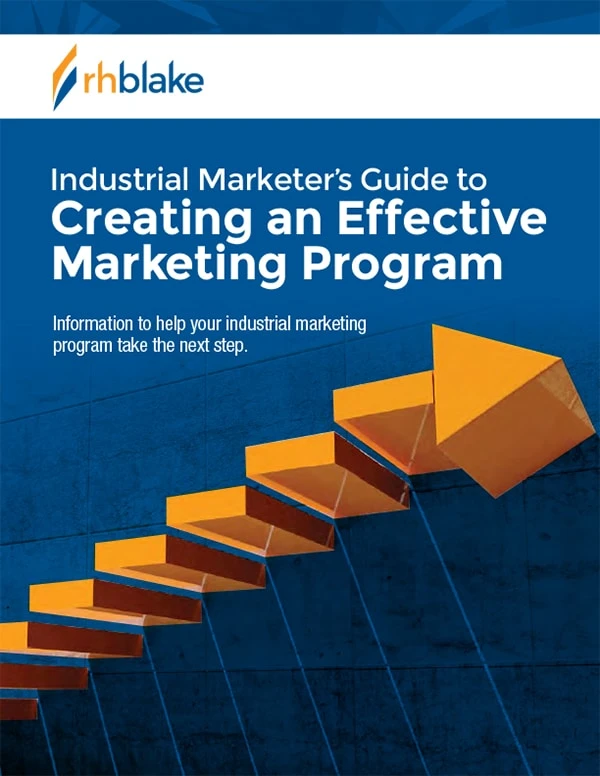
Industrial Marketer’s Guide to Creating an Effective Marketing Program
147 pages of actionable ideas to help you create a winning marketing strategy and program

Industrial Marketer’s Guide to Creating an Effective Marketing Program
147 pages of actionable ideas to help you create a winning marketing strategy and program
Related Clients



